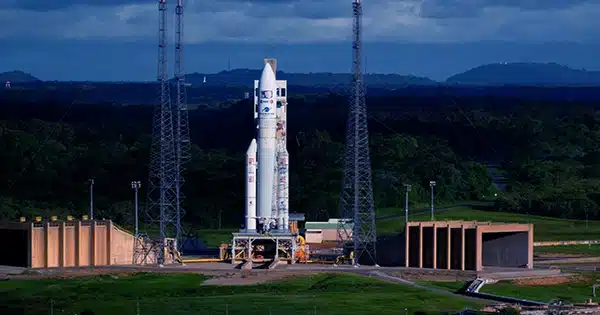The Ariane 5 rocket has been in service for nearly three decades, launching satellites and missions. Over time, the iconic rocket, which features a liquid hydrogen-fueled core stage and solid rocket boosters, has come to represent Europe’s unrivaled access to space.
However, the Ariane 5’s journey is coming to a close. The final Ariane 5 rocket will launch from Kourou, French Guiana, on Tuesday evening, delivering a French military communications satellite and a German communications satellite to geostationary transfer orbit. At 5:30 p.m. ET (21:30 p.m. UTC), a 90-minute launch window opens. The launch will be shown live on ESA TV.
History: The Ariane 5 rocket launched for the first time in June 1996, and its second launch a year later was similarly a partial failure. However, the rocket has had a good track record of success in 116 total launch attempts. For most of its life, the rocket was a genuine workhorse, carrying scores of commercial satellites into geostationary orbit and ensuring that European nations could launch national security payloads into orbit.

The rocket has also carried key space science missions such as the Rosetta, Herschel, Planck, BepiColombo, and JUICE probes. The rocket’s most significant launch occurred in December 2021, when it lofted NASA’s James Webb Space Telescope into a very precise orbit.
NASA was able to double the mission’s expected duration because Webb did not require any onboard fuel to adjust its orbit. According to Mike Menzel, a NASA systems engineer, an agency examination discovered that Webb has enough fuel on board for 20 years of life, up from the original estimate of 10 years.
Considering the Future: That is the most exciting aspect of the Ariane 5 rocket’s story. The bitter part comes as Europe looks forward. The continent’s space officials knew about a decade ago that the Ariane 5 was not very cost-competitive with newer rockets, particularly SpaceX’s Falcon 9 launcher. As a result, they chose to create a more affordable next-generation rocket, the Ariane 6.
This new rocket was essentially a modernization of the Ariane 5, featuring a revised design for the solid rocket booster and the primary engine, the Vulcain. According to European space experts, the Ariane 6 rocket will be ready for its first flight in 2020.
Unfortunately, it is apparent as of July 2023 that the Ariane 6 rocket will not fly before next year, and most likely not until the summer of 2024. Officials from Arianespace and other European organizations recently rejected to provide a new expected debut launch date at the Paris Air Show. There is still much work to be done, including another hot fire test of the rocket’s upper stage, flight software certification tests, and rocket assembly on the launch pad.
Real-world consequences: These delays are detrimental to Europe’s launch industry. Remember that the content developed the Ariane 6 rocket to compete with the Falcon 9. Due to continuous delays, the European Space Agency is now forced to shift some of its most important missions onto the SpaceX rocket.
Europe, for example, launched its high-value Euclid space telescope on the Falcon 9 rocket on Saturday since an operational Ariane 6 rocket would not be ready until at least 2025.
Delays with the Ariane 6 launch have also caused the European Space Agency to agree to launch its Hera asteroid probe from Cape Canaveral in 2024 on a Falcon 9. In addition, the space agency’s director general, Josef Aschbacher, stated that EarthCARE, an Earth science satellite, will have to launch on a SpaceX Falcon 9 due to issues with its European Vega C rocket.
Aschbacher recently recognized that Europe has slipped substantially behind SpaceX in terms of launch capabilities.
“SpaceX has undeniably changed the launcher market paradigm as we know it,” he said in May. “With the dependability of Falcon 9 and the allure of Starship, SpaceX continues to completely redefine the world’s access to space, pushing the boundaries of possibility as they go.” Starship, if successful, will lift payloads of roughly 100 tonnes into Low Earth Orbit while cutting launch costs by a factor of ten. In 2023, Falcon 9 plans to launch 100 times. Europe, on the other hand, is currently experiencing a severe launcher crisis.”
As the final Ariane 5 takes off, Europe is sailing into uncharted waters until the Ariane 6 can eventually take off.











